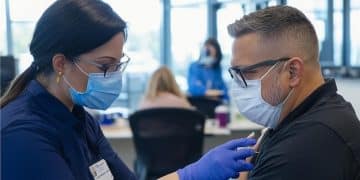Protecting Children’s Health: Immunizations and Lead Prevention Guide

Protecting children’s health involves staying informed about the latest recommendations on childhood immunizations to prevent infectious diseases and implementing strategies to minimize lead exposure, thereby ensuring their healthy development and well-being.
Protecting children’s health: A guide to the latest recommendations on childhood immunizations and lead exposure prevention is paramount for their well-being. Let’s explore these critical aspects.
Understanding Childhood Immunizations
Childhood immunizations are a cornerstone of preventive healthcare, shielding children from a range of infectious diseases. These vaccines work by stimulating the body’s immune system to recognize and fight off specific pathogens, providing long-term protection against potentially life-threatening illnesses.
The Importance of Vaccination Schedules
Following a recommended vaccination schedule is crucial to ensure children receive timely protection. These schedules are developed by experts and tailored to provide optimal immunity at different stages of development.
Addressing Common Concerns About Vaccines
It’s natural for parents to have questions or concerns about vaccines. Understanding the science behind vaccines and addressing these concerns is vital for making informed decisions.
- Myth: Vaccines cause autism. Fact: Numerous scientific studies have debunked this claim.
- Concern: Too many vaccines at once overwhelm the immune system. Fact: Children’s immune systems are capable of handling multiple vaccines.
- Question: Are vaccine side effects dangerous? Answer: Side effects are generally mild and temporary.
Staying informed about the facts surrounding vaccines can help alleviate fears and promote confidence in their safety and effectiveness. Regular consultation with healthcare providers can further enhance understanding and address individual concerns.
Childhood immunizations protect kids from potentially dangerous illnesses. Understanding their schedules and addressing any concerns about vaccines keeps children healthy and thriving in their formative years.

Lead Exposure: Risks and Sources
Lead exposure can have severe and lasting effects on children’s health and development. Even low levels of lead in the blood can cause neurological and behavioral problems. Understanding the risks and sources of lead exposure is essential for prevention.
Common Sources of Lead Exposure
Lead can be found in various places, making it important to identify and mitigate potential sources. Older homes, contaminated water, and certain products are common culprits.
Health Consequences of Lead Exposure
Lead exposure can lead to a variety of health issues, affecting children’s cognitive, behavioral, and physical development.
- Cognitive Impairment: Lead can lower IQ and affect learning abilities.
- Behavioral Issues: Exposure can lead to hyperactivity and attention deficits.
- Physical Health: Lead can cause anemia and kidney problems.
Being aware of the health consequences of lead exposure can motivate parents and caregivers to take proactive measures to protect children. Regular medical check-ups can help detect lead exposure early, enabling timely intervention and management.
Identifying risks, sources, and consequences of lead exposure enables parents to proactively safeguard their children’s health and development. Regular check-ups and awareness are key to early detection and intervention.
Preventing Lead Exposure in Children
Preventing lead exposure requires a multi-faceted approach, focusing on identifying and eliminating potential sources. Simple steps can significantly reduce the risk of lead poisoning and promote a healthier environment for children.
Testing Your Home for Lead
Testing your home for lead, particularly in older homes, is a critical step in preventing lead exposure. Lead-based paint and contaminated water are common concerns that require inspection.
Safe Practices to Reduce Lead Exposure
Adopting safe practices in your home and daily routines can minimize the risk of lead exposure. These range from careful cleaning to awareness of products that may contain lead.
- Regular Cleaning: Wash surfaces and toys frequently to remove lead dust.
- Water Safety: Use cold water for drinking and cooking, and flush pipes if water has been stagnant.
- Product Awareness: Avoid using imported or handmade products that may contain lead.
Regular cleaning, prioritizing water safety, and being mindful of product origins help maintain a lead-safe environment for children. Early detection and proactive measures can ensure a healthier start in life.
Testing your home and following safe practices are vital steps in preventing lead exposure among children. Diligence turns every home into a haven of health, safeguarding future generations.

The Role of Nutrition in Protecting Children’s Health
Nutrition plays a pivotal role in protecting children’s health, providing the essential nutrients needed for proper growth, development, and immune function. A balanced diet can also help mitigate the effects of lead exposure.
Nutrients That Help Combat Lead Absorption
Certain nutrients can help reduce the absorption of lead in the body, providing an extra layer of protection for children exposed to lead.
Creating a Balanced Diet for Children
Establishing a balanced diet rich in essential vitamins and minerals supports overall health and strengthens children’s resilience against environmental toxins like lead.
- Iron-Rich Foods: Help prevent iron deficiency, which can increase lead absorption.
- Calcium: Reduces lead absorption and promotes strong bones.
- Vitamin C: Enhances the immune system and protects against lead toxicity.
Providing iron-rich foods, calcium, and vitamin C through a balanced diet helps children combat the ill effects of lead and supports their growth. A nourishing diet is a foundational element in protecting children’s health and well-being.
Proper nutrition can significantly enhance children’s immune system and reduce the impacts of lead. Prioritizing a balanced diet strengthens resilience, ensuring a healthier future.
Community Resources and Support
Accessing community resources and support networks is crucial for protecting children’s health. These resources provide valuable information, services, and assistance to families concerned about immunizations and lead exposure.
Local Health Departments and Clinics
Local health departments and clinics offer a range of services, including vaccinations, lead screenings, and educational programs. They are a valuable source of information and support.
Non-Profit Organizations and Support Groups
Non-profit organizations and support groups provide additional resources and support for families. These organizations often offer educational materials, counseling services, and advocacy efforts.
- Educational Programs: Learn about immunizations and lead prevention.
- Counseling Services: Get emotional support and guidance.
- Advocacy: Participate in efforts to improve children’s health policies.
Community resources provide families with essential information, support, and services, fostering a collective effort to protect children’s health. Engaging with such organizations can empower parents and caregivers to make informed decisions and advocate for their children’s well-being.
Community resources are invaluable for families, providing necessary support and education to protect children’s health. United efforts ensure every child has the opportunity to thrive in a safe and healthy environment.
Advocating for Children’s Health Policy
Advocating for children’s health policy involves engaging with local and national governments to promote policies that support childhood immunizations and lead exposure prevention. Collective action can drive meaningful change.
Engaging with Local and National Governments
Engaging with government officials and policymakers can influence the development and implementation of effective health policies. Contacting representatives, attending public hearings, and participating in advocacy campaigns are impactful ways to make your voice heard.
Supporting Policies That Protect Children
Supporting policies that prioritize childhood immunizations and lead exposure prevention is essential for creating a healthier future. These policies ensure access to vaccinations and promote lead-safe environments.
- Vaccination Programs: Advocate for comprehensive immunization initiatives.
- Lead Remediation: Support funding for lead abatement programs.
- Education: Promote public awareness campaigns about children’s health.
Advocating for strong policies that prioritize children’s health creates safer, healthier communities. Collective action and engagement with policymakers make a powerful difference in ensuring every child has the opportunity to thrive.
Advocating strengthens policies, safeguards communities, and ensures healthier futures for children. United action makes a tangible difference in children’s lives, building a better tomorrow.
| Key Area | Brief Description |
|---|---|
| 💉 Immunizations | Protect children from infectious diseases through timely vaccinations following recommended schedules. |
| 🏠 Lead Prevention | Minimize lead exposure by testing homes, adopting safe practices, and identifying potential sources. |
| 🍎 Nutrition | Promote a balanced diet to support growth, immune function, and combat lead absorption. |
| 🤝 Community Support | Utilize local resources for vaccinations, screenings, education, and family support. |
Frequently Asked Questions
▼
Childhood immunizations protect children from serious and potentially life-threatening infectious diseases, preventing outbreaks and promoting overall public health.
▼
Common sources include lead-based paint in older homes, contaminated water, dust, and certain imported toys or products, posing significant risks.
▼
You can purchase a lead testing kit or hire a certified lead inspector to assess paint, dust, soil, and water for lead contamination.
▼
Iron, calcium, and vitamin C help reduce lead absorption. Include iron-rich foods, calcium-rich dairy, and citrus fruits in their diet.
▼
Local health departments, clinics, and non-profit organizations often offer services, educational materials, and support groups for families regarding children’s health issues.
Conclusion
Protecting children’s health through immunization and lead exposure prevention is crucial for ensuring their healthy development. By staying informed, taking preventive measures, and engaging with community resources, we can create a safer and healthier environment for all children.





